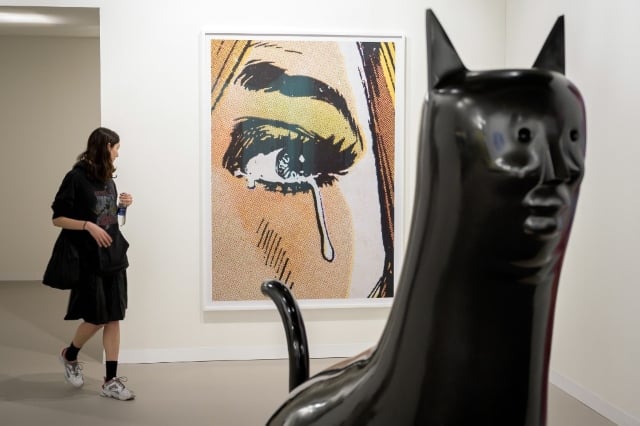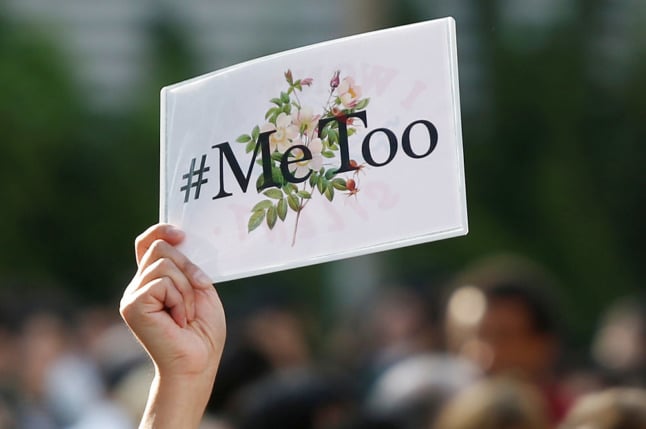The #MeToo movement that exploded on the global stage in late 2017 has inspired several works exhibited at this year's Art Basel, the world's biggest contemporary art fair, which opens to the public on Thursday.
Women artists have taken centre stage at the show's 50th edition, with in-your-face installations expressing disgust and exasperation at persisting gender inequalities and culturally condoned abuse and harassment of women.
Spanish artist Alicia Framis has filled a room with delicate, white mannequins wearing different styles of dresses made from airbag material, which inflate to protect different parts of the female body.
The piece called “Life Dress” consists of dresses “to protect women in all work situations where there is some kind of abuse,” Framis told AFP.
The 52-year-old artist said she had spoken with victims of harassment and abuse and allowed their stories to inspire the dress designs, using “fashion to demonstrate against violence.”
Where Framis uses humour to spotlight abuse, Los Angeles-based artist Andrea Bowers's massive archival project “Open Secrets” radiates rage.
.jpg)
Andrea Bower's “Open Secrets” has already caused controversy. Photo: AFP
It consists of reams of photographic prints on red backgrounds, each listing the name and occupation of a public figure accused of sexual harassment or abuse, their public response to the accusations and details of the case.
'Rape culture'
Disgraced film mogul Harvey Weinstein, whose misconduct first sparked the #MeToo movement, has two full panels dedicated to his long list of alleged misdeeds.
US President Donald Trump also figures in the piece, as do his predecessors Bill Clinton and George Bush Senior, two Supreme Court justices, as well as actors, journalists, musicians and other public figures.
“I just felt like the #MeToo movement is perhaps one of the most important feminist movements of my lifetime,” Bowers told AFP, explaining her inspiration for the piece.
The 54-year-old self-described feminist activist artist said she had been shocked to realise “what it was like for me growing up, that it was rape culture, where … young men were given permission to sexually violate me and my friends.”
With the #MeToo movement, such behaviour is finally “being acknowledged,” she said. “I hope that it's a historic shift.”
During a preview earlier this week, men in particular lingered in front of the piece which covers two long walls, back and front, in the middle of the fair's Unlimited exhibition space.
“You can see a lot of men standing here and being a bit unsure how to react,” said Vanja Oberhoff, a young German art investor standing among some dozen men gazing at the articles.
“It's a very strong piece,” he told AFP.
Not all reactions have been positive.
Helen Donahue, who in 2017 tweeted out photographs of herself bearing the marks of alleged abuse by freelance columnist Michael Hafford, voiced outrage that Bowers had used one of the pictures.
“Cool that my fucking photos and trauma are heading art basel thx for exploiting us for 'art' ANDREA BOWERS,” she tweeted on Tuesday.
cool that my fucking photos and trauma are heading art basel thx for exploiting us for “art” ANDREA BOWERS @unavailabl DO YOU KNOW HOW FUCKING INSANE IT IS TO FIND OUT MY BEAT UP FACE AND BODY ARE ON DISPLAY AS ART RN FOR RICH PPL TO GAWK AT THRU A STRANGER’S INSTAGRAM STORY pic.twitter.com/5X9vF5hZE5
— helen (@helen) June 11, 2019
Bowers, who insists on the importance of trusting survivors, quickly issued an apology for not seeking Donahue's consent before using the picture and removed the panel from the exhibit.
'Equalisation'?
The artist also told AFP that showing her piece at Art Basel had been more challenging than she had expected.
The VIP opening of the show drew “some of the richest people in the world, and they actually know many of the people on the walls, because these are also some of the most powerful people in the world,” Bowers said.
“This is an emotional piece for a lot of people here because it is very personal.”
The piece shows “we have to change our thinking, and not everybody is ready to do that… There is still a lot more work to be done.”
This year's Art Basel is also abuzz with discussion about disparities between the prices raked in for pieces made by male and female artists, as well as access to gallery representation.
Clare McAndrew, a cultural economist who writes the annual Art Market Report released each year ahead of Art Basel, told AFP that women still face “stark under-representation” in the art world.
“Only five percent of the work sold last year at auction were by female artists, and the higher up the price point you go, the worse that gets,” she said, adding that even at galleries only showing contemporary art, women account for about a third of the represented artists.
Marc Glimcher, who heads Pace Gallery, a global leader in contemporary art, acknowledged that the most talented women artists have long made only about a 10th of the amount made by contemporary male artists, if they were lucky.
But he told AFP that “an equalisation is taking place”.
“The market recognises that there was an arbitrary depression of value, and a possible opportunity.”



 Please whitelist us to continue reading.
Please whitelist us to continue reading.
Member comments